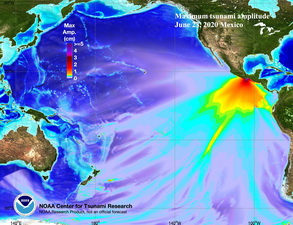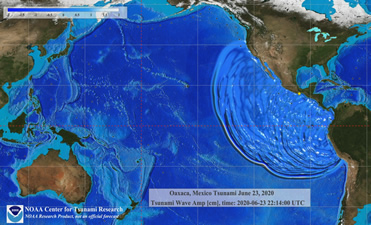Not an official forecast
Oaxaca, Mexico Tsunami, June 23, 2020
Main Event Page
|
The June 23, 2020, Mexican tsunami was generated by a Mw 7.4 earthquake (15.932°N 95.937°W), at 2020-06-23 15:29:04 UTC (according to the USGS). The first peak of the tsunami of ~20 cm was detected at the nearby Salina Cruz tide station 50 minutes after the earthquake, and the largest tsunami amplitude of 68 cm occurred 70 minutes later, probably due to strong local wave resonance. The first and largest peak of the tsunami waveform in the deep ocean was detected at DART 43413 located 720 km southwest of the epicenter, approximately 1 hour after the earthquake with a maximum wave amplitude of just over 0.7 cm. Model results shown below were created with the NOAA forecast method using the MOST model via automatic inversion of the source with NOAA's TFS (Tsunami Forecast System). The graphics display preliminary modeling analysis, showing qualitative and quantitative information about the tsunami, including tsunami wave interaction with ocean floor bathymetric features, and neighboring coastlines. Tsunami model amplitude information is shown color-coded according to the scale bar.
Preliminary Model Comparison of the June 23, 2020 Mexican tsunami recorded at tsunameter/DARTs and tide gauges with model results.
It is noted that all above model results are preliminary. The tsunami source is estimated from inversion of observed waveforms at DARTs using limited number of unit sources. The discrepancies between model results and tide gauge observation are mostly due to our limited knowledge of the earthquake/tsunami source configuration at this point, and the low-quality bathymetric information, particularly at Salina Cruz of Mexico, that can't fully reproduce the wave amplification resulting from the harbor resonance. |
||||
Disclaimer: The models on these pages show the results of ongoing research to enhance tsunami science and to improve NOAA operational tsunami forecasts. These products were developed during or shortly after the tsunami event, are intended for research use, and are not an official forecast. They should not be used as the basis of any public or private policy decisions. Please contact NCTR to find if there are more detailed follow-on analysis results.
For media inquiries:
When using information from this page, please credit NOAA / PMEL / Center for Tsunami Research


